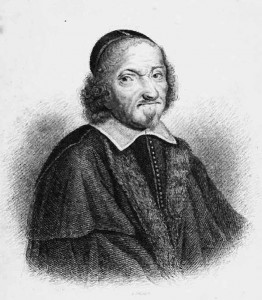 On 20th January 1569, Bible translator and Bishop of Exeter, Miles (Myles) Coverdale died. He was buried in the chancel of St Bartholomew by the Exchange, London, on 22nd January.
On 20th January 1569, Bible translator and Bishop of Exeter, Miles (Myles) Coverdale died. He was buried in the chancel of St Bartholomew by the Exchange, London, on 22nd January.
It is thought that Coverdale was born in the North Riding of Yorkshire in 1488, although nothing is known of his family or early life. He became an Augustinian friar and studied at Cambridge, where he was influenced by the reformist views of Robert Barnes. His whereabouts in the late 1520s and early 1530s are not known, but he was in Antwerp by 1534 with John Rogers and William Tyndale. That year, an English translation of Campensis’ Latin work on the psalms was published in Antwerp, and it is believed that this was written by Tyndale, who had already started his translation of the Bible. His translation was completed in October 1535, and was the first English translation of the whole Bible.
He returned to England in late 1535 and published his translation of German hymns, “Goostly Psalmes and Spirituall Songs Drawen out of the Holy Scripture”, in London. This was followed by translations of other German religious texts. In 1537, Thomas Cromwell asked Coverdale to revise the “Matthew Bible”, a Bible which combined the work of Tyndale and Coverdale, and print it in Paris. However, there was trouble when one of those overseeing the printing was accused of heresy, and around 2500 finished copies were confiscated by the Inquisition and eventually burned. Fortunately, the publishers, Richard Grafton and Edward Whitchurch, managed to flee Paris with some unbound copies. In April 1539, 3000 copies of the “Great Bible” were printed, followed by another 3000 copies in spring 1540. This meant that a copy could be put into every church in England.
The Act of the Six Articles of June 1539 led to many reformers, Coverdale included, going into exile to escape persecution. Coverdale’s former mentor, Robert Barnes, was executed for heresy in July 1540, as was Thomas Cromwell. England was not safe for Coverdale. He fled to Strasbourg, where he stayed for three years, translating and writing tracts. He returned to England in 1548, during the reign of Edward VI, and became Almoner to Catherine Parr, the Dowager Queen. After her death in September 1548, he became a Royal Chaplain and then Bishop of Exeter in 1551. The death of the Protestant Edward VI saw Coverdale put under house arrest when Mary I came to the throne, and losing his bishopric. The King of Denmark intervened to have Coverdale released, and in 1555 he went into exile, spending a few weeks in Denmark before heading to Bergzaben, then Aarau in Switzerland and finally Geneva.
Coverdale returned to England in 1559, in Elizabeth I’s reign, and began preaching. In 1564 he accepted the living of St Magnus the Martyr by London Bridge, but resigned in the summer of 1566. He carried on preaching, though, and died immediately after standing in for a preacher at the church of St Magnus the Martyr in London. Although he was buried in St Bartholomew by the Exchange, his remains were moved to St Magnus the Martyr when St Bartholomew’s was pulled down in 1840.
Taken from On This Day in Tudor History by Claire Ridgway